Global Burden of Sickle Cell Anaemia in Children under Five, 2010–2050: Modelling Based on Demographics, Excess Mortality, and Interventions
Background:
The global burden of sickle cell anaemia (SCA) is set to rise as a consequence of improved survival in high-prevalence low - and middle-income countries and population migration to higher-income countries. The host of quantitative evidence documenting these changes has not been assembled at the global level. The purpose of this study is to estimate trends in the future number of newborns with SCA and the number of lives that could be saved in under-five children with SCA by the implementation of different levels of health interventions.
Methods and Findings:
First, we calculated projected numbers of newborns with SCA for each 5-y interval between 2010 and 2050 by combining estimates of national SCA frequencies with projected demographic data. We then accounted for under-five mortality (U5m) projections and tested different levels of excess mortality for children with SCA, reflecting the benefits of implementing specific health interventions for under-five patients in 2015, to assess the number of lives that could be saved with appropriate health care services. The estimated number of newborns with SCA globally will increase from 305,800 (confidence interval [CI]: 238,400–398,800) in 2010 to 404,200 (CI: 242,500–657,600) in 2050. It is likely that Nigeria (2010 : 91,000 newborns with SCA [CI: 77,900–106,100]; 2050 : 140,800 [CI: 95,500–200,600]) and the Democratic Republic of the Congo (2010 : 39,700 [CI: 32,600–48,800]; 2050 : 44,700 [CI: 27,100–70,500]) will remain the countries most in need of policies for the prevention and management of SCA. We predict a decrease in the annual number of newborns with SCA in India (2010 : 44,400 [CI: 33,700–59,100]; 2050 : 33,900 [CI: 15,900–64,700]). The implementation of basic health interventions (e.g., prenatal diagnosis, penicillin prophylaxis, and vaccination) for SCA in 2015, leading to significant reductions in excess mortality among under-five children with SCA, could, by 2050, prolong the lives of 5,302,900 [CI: 3,174,800–6,699,100] newborns with SCA. Similarly, large-scale universal screening could save the lives of up to 9,806,000 (CI: 6,745,800–14,232,700) newborns with SCA globally, 85% (CI: 81%–88%) of whom will be born in sub-Saharan Africa. The study findings are limited by the uncertainty in the estimates and the assumptions around mortality reductions associated with interventions.
Conclusions:
Our quantitative approach confirms that the global burden of SCA is increasing, and highlights the need to develop specific national policies for appropriate public health planning, particularly in low - and middle-income countries. Further empirical collaborative epidemiological studies are vital to assess current and future health care needs, especially in Nigeria, the Democratic Republic of the Congo, and India.
Please see later in the article for the Editors' Summary
Published in the journal:
. PLoS Med 10(7): e32767. doi:10.1371/journal.pmed.1001484
Category:
Research Article
doi:
https://doi.org/10.1371/journal.pmed.1001484
Summary
Background:
The global burden of sickle cell anaemia (SCA) is set to rise as a consequence of improved survival in high-prevalence low - and middle-income countries and population migration to higher-income countries. The host of quantitative evidence documenting these changes has not been assembled at the global level. The purpose of this study is to estimate trends in the future number of newborns with SCA and the number of lives that could be saved in under-five children with SCA by the implementation of different levels of health interventions.
Methods and Findings:
First, we calculated projected numbers of newborns with SCA for each 5-y interval between 2010 and 2050 by combining estimates of national SCA frequencies with projected demographic data. We then accounted for under-five mortality (U5m) projections and tested different levels of excess mortality for children with SCA, reflecting the benefits of implementing specific health interventions for under-five patients in 2015, to assess the number of lives that could be saved with appropriate health care services. The estimated number of newborns with SCA globally will increase from 305,800 (confidence interval [CI]: 238,400–398,800) in 2010 to 404,200 (CI: 242,500–657,600) in 2050. It is likely that Nigeria (2010 : 91,000 newborns with SCA [CI: 77,900–106,100]; 2050 : 140,800 [CI: 95,500–200,600]) and the Democratic Republic of the Congo (2010 : 39,700 [CI: 32,600–48,800]; 2050 : 44,700 [CI: 27,100–70,500]) will remain the countries most in need of policies for the prevention and management of SCA. We predict a decrease in the annual number of newborns with SCA in India (2010 : 44,400 [CI: 33,700–59,100]; 2050 : 33,900 [CI: 15,900–64,700]). The implementation of basic health interventions (e.g., prenatal diagnosis, penicillin prophylaxis, and vaccination) for SCA in 2015, leading to significant reductions in excess mortality among under-five children with SCA, could, by 2050, prolong the lives of 5,302,900 [CI: 3,174,800–6,699,100] newborns with SCA. Similarly, large-scale universal screening could save the lives of up to 9,806,000 (CI: 6,745,800–14,232,700) newborns with SCA globally, 85% (CI: 81%–88%) of whom will be born in sub-Saharan Africa. The study findings are limited by the uncertainty in the estimates and the assumptions around mortality reductions associated with interventions.
Conclusions:
Our quantitative approach confirms that the global burden of SCA is increasing, and highlights the need to develop specific national policies for appropriate public health planning, particularly in low - and middle-income countries. Further empirical collaborative epidemiological studies are vital to assess current and future health care needs, especially in Nigeria, the Democratic Republic of the Congo, and India.
Please see later in the article for the Editors' Summary
Introduction
While considerable efforts are currently being invested into reducing the global burden of infectious diseases, particularly malaria, tuberculosis, and HIV [1],[2], the burden of birth defects has largely been neglected [3]–[5]. It has recently been estimated that more than 7 million babies are born each year with either a congenital abnormality or a genetic disease [3]. Five disorders constitute approximately 25% of these births, two of which, haemoglobinopathy and glucose-6-phosphate dehydrogenase deficiency, are monogenic diseases [6].
Amongst the haemoglobinopathies, sickle cell disease is by far the largest public health concern. Sickle haemoglobin (HbS) is a structural variant of normal adult haemoglobin (HbA) that is inherited as an autosomal recessive Mendelian trait. While heterozygote individuals are generally asymptomatic, homozygote individuals (i.e., those with SCA) suffer from lifelong acute and chronic complications [7]. Although sickle cell disorders include not only SCA but also co-inherited haemoglobin S and haemoglobin C (HbSC disease) or β-thalassaemia (HbS/β-thalassaemia), the present study focuses exclusively on SCA, the most severe and most common globally, accounting for an estimated 83% of all newborns with sickle cell disorders [8].
Because of evolutionary selection due to malaria protection, the highest frequencies of SCA are seen in tropical regions [9]. The vast majority of newborns with SCA occur in low - and middle-income countries. Without early diagnosis and treatment, most of those affected die during the first few years of life, with reported excess mortality reaching up to 92% [10]. Furthermore, infectious diseases have a role in causing increased severity of SCA [11],[12]. As low - and middle-income countries go through epidemiological transition and improve hygiene, nutrition, and public health policies and infrastructures, impressive reductions in overall infant and childhood mortality have started to be observed [13]–[16].
Following population migration, SCA is now seen throughout the world, as illustrated by the implementation of universal screening programmes in the United States of America, in the United Kingdom, and in French overseas territories. As it seems likely that human migration will continue to increase with further globalisation [17], the implementation of prevention measures, including diagnosis and counselling, in low - and middle-income countries will be of direct relevance for high-income countries.
Awareness about the clinical and economic burden of SCA is rising, albeit slowly. In 2006, the World Health Organization (WHO) recognised SCA as a global public health problem [18]. In 2010, the 63rd World Health Assembly adopted a resolution on the prevention and management of birth defects, including sickle cell disease and the thalassaemias. Finally, haemoglobinopathies have been included in the most recent Global Burden of Diseases, Injuries, and Risk Factors Study (the GBD 2010 study), which aims at providing a comprehensive and systematic evidence-based assessment of the burden of major diseases and injuries [19].
Quantitative studies provide essential evidence on which to base public health decisions [20]. No such studies are currently available for either SCA or other birth defects. We recently estimated national allele frequencies for HbS using a contemporary database of representative population surveys and a Bayesian geostatistical framework [21]. By combining our estimates with high-resolution data on crude birth rates and population densities, we were able to estimate the global number of SCA-affected births by country for 2010. Here, we use these estimates and demographic projections to (i) assess the magnitude of the expected increase in the global burden of SCA between 2010 and 2050, (ii) identify the countries most likely to be affected by changes over the next decades, and (iii) provide quantitative evidence to guide public health decisions at global, regional, and national scales.
Methods
We conducted a quantitative investigation of the trends in the number of newborns with SCA at national, regional, and global scales. We then used a scenario-based approach that accounted for differences between low-, middle-, and high-income countries. Population movements are not considered in this study because of their unpredictable nature and a lack of systematic data for their prediction at the global level. Our model approach is summarised in Figure 1, and a worked example showing how values were calculated for Nigeria is presented in Table S1. A summary of the assumptions made in this study is shown in Table 1.
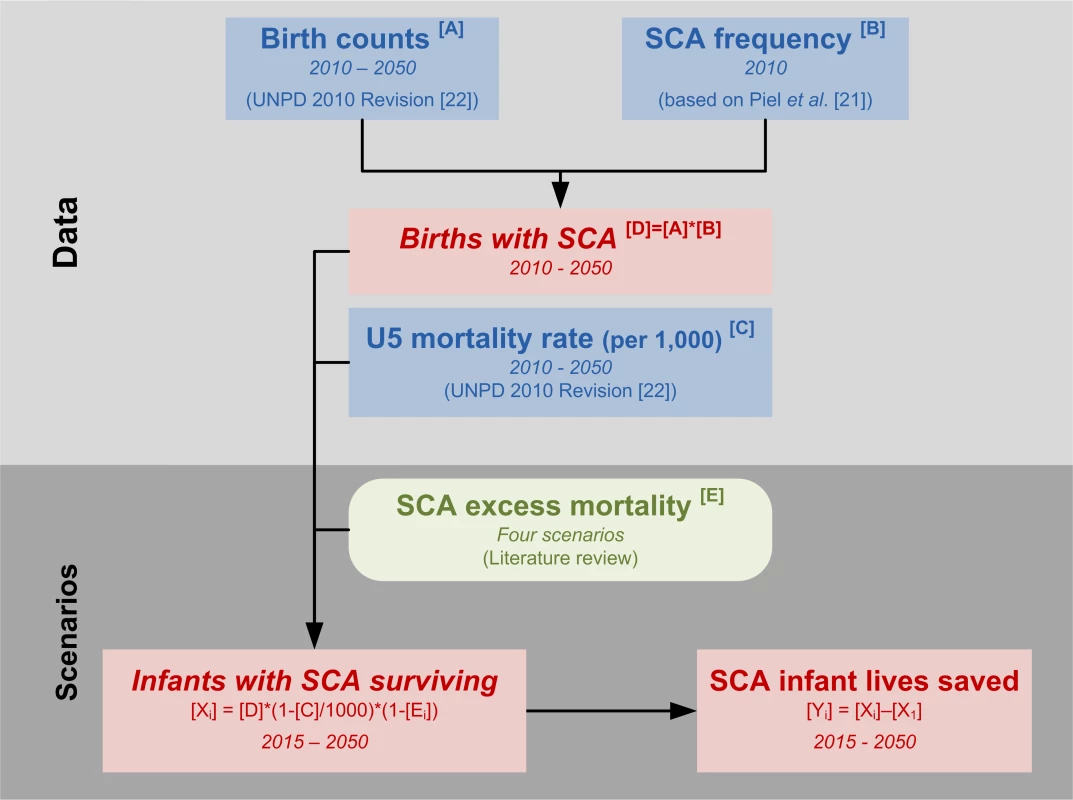
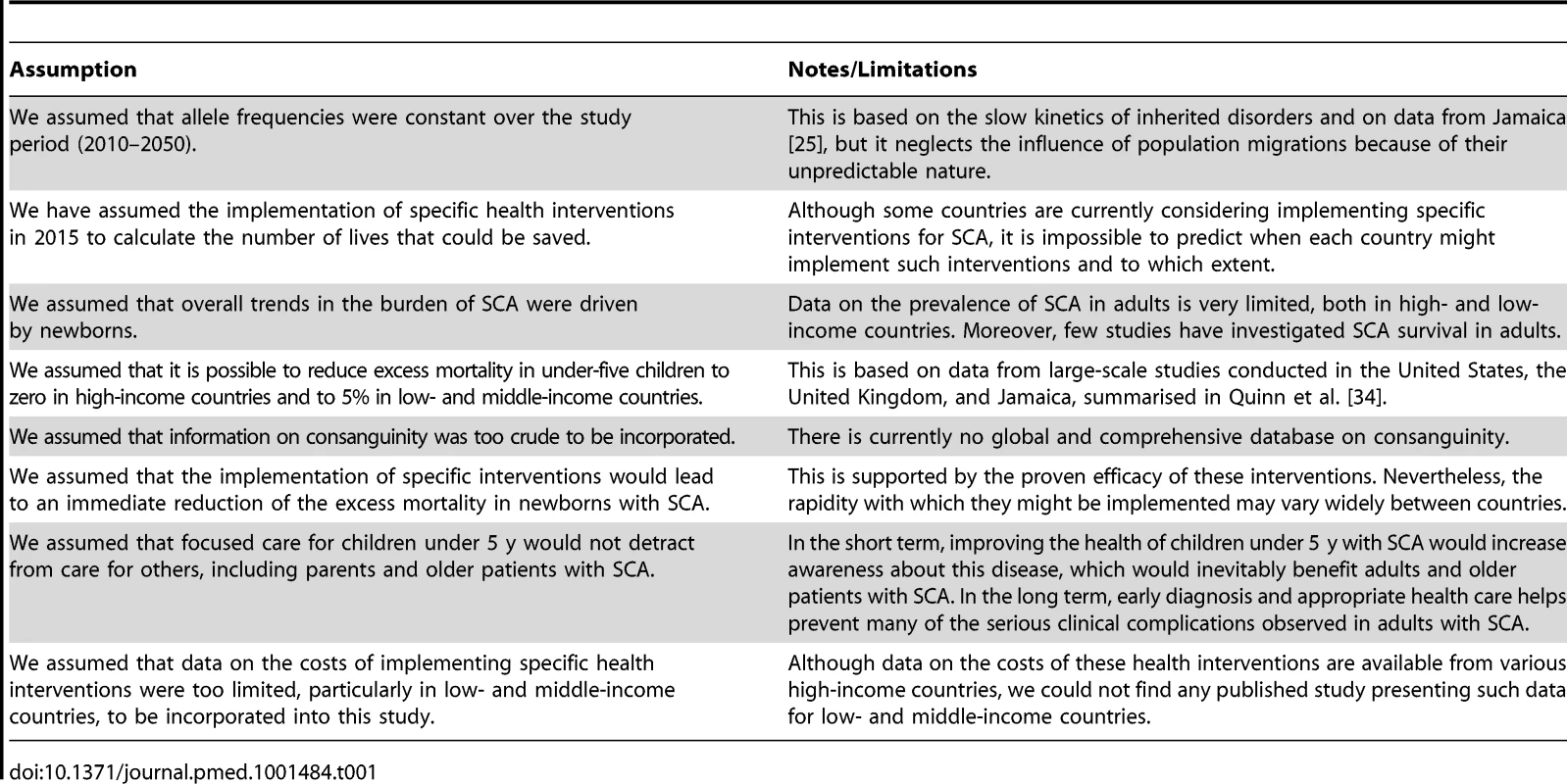
Projected Number of Newborns with SCA
Our projections of the number of newborns with SCA are based on the product of estimates of SCA frequency and projected birth counts. For SCA, we have used the median and interquartile range—the interval between the 25% and 75% quantiles of the predicted posterior distribution—of our own frequency estimates for 2010 [21]. Although only estimates of allele frequencies were previously published, SCA frequencies were also calculated within the Bayesian geostatistical framework used. For birth counts, we used medium-, low-, and high-fertility variant projections for 5-y periods between 2010 and 2050 from the 2010 revision of the United Nations World Population Prospects [22]. The lower bound of our confidence intervals (CIs) is based on the 25% quantile for SCA estimates and the low-fertility variant for birth counts. The higher bound of our CIs is based on the 75% quantile for SCA estimates and the high-fertility variant for birth counts. Data, with CIs, are presented for each country and for WHO regions, HbS regions (as defined in [21]), and the world in Table S2.
We generated cartograms of the number of newborns with SCA in 2010, 2050, and over the period studied (2010–2050) (Figure 2) using the Cartogram Geoprocessing Tool in ArcGIS 10.1 (Esri). Cartograms are maps distorted proportionally to a variable other than land area or geographical space [23],[24]. They help to draw attention to regions or countries that are overrepresented or underrepresented when considering the particular variable mapped.
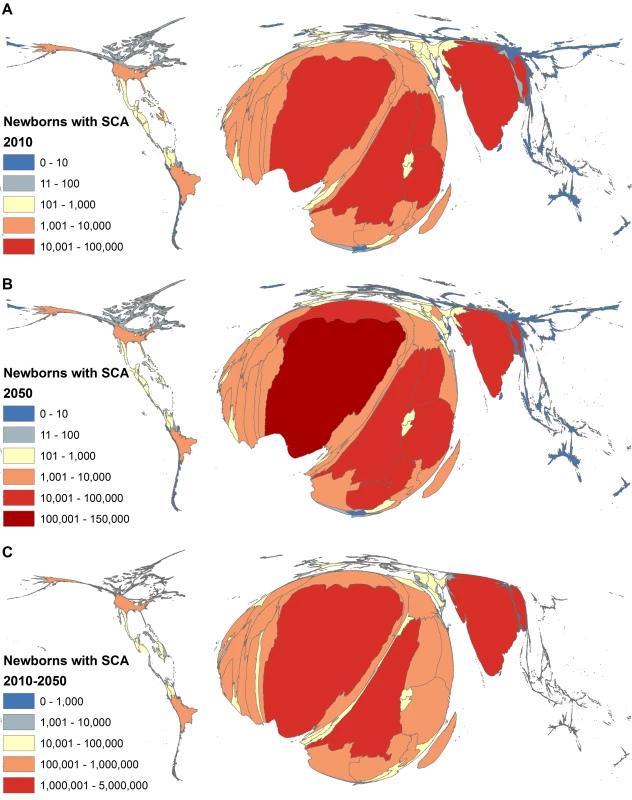
We then ranked countries based on the magnitude of the absolute change in the estimated median number of newborns with SCA born between 2010 and 2050 (Table S2). Countries in which the increase in the number of newborns with SCA was the highest over the study period were assigned the lowest rank, while countries in which the decrease in the number of newborns with SCA was the highest over the study period were assigned the highest rank. Ranks are shown in Table S2. For illustrative purposes, we have limited this analysis to countries with a SCA frequency higher than 0.001 and in which more than 100 newborns with SCA were estimated for 2010 (Figure 3A). We applied a logarithmic transformation to further illustrate relative changes (Figure 3B).
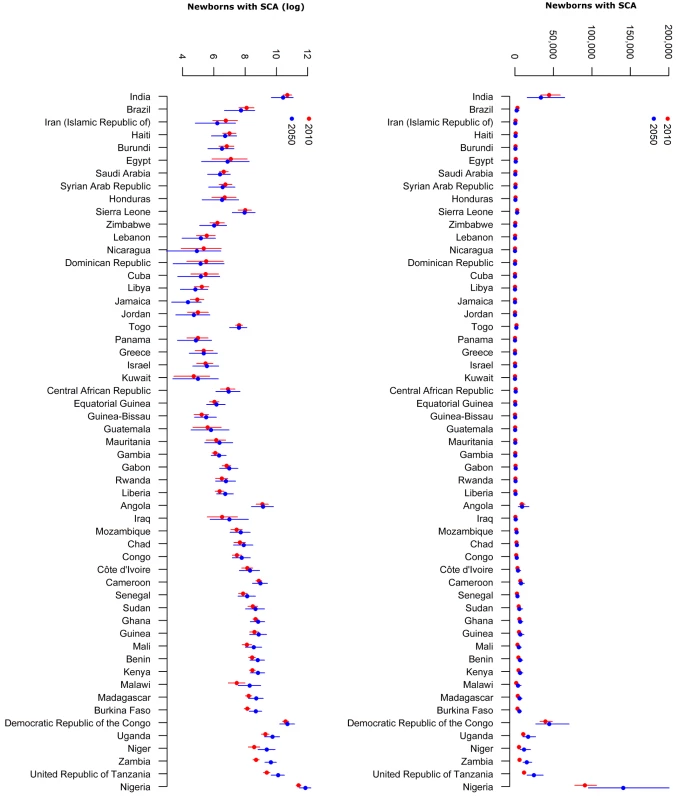
Lives Saved Scenarios
Because of the inheritance mechanism of the sickle cell gene, changes in SCA allele frequency occur slowly, over generations [23],[24]. Studies conducted in Jamaica suggest that even in the absence of positive selection for heterozygotes the prevalence of newborns with SCA will remain stable over very long periods of time [25]. For the purposes of this analysis, we therefore assumed that the prevalence of newborns with SCA will remain constant during the period under study (2010–2050). Although few data are available regarding SCA mortality, particularly in the areas of highest prevalence, sharp reductions in SCA mortality in young children following the implementation of specific health measures are well documented in the US [26],[27] and Jamaica [28],[29]. Having calculated the baseline number of expected newborns with SCA at global, regional, and national scales by 5-y intervals from 2010–2050, we then tested the following four scenarios assuming the implementation in 2015 of the health measures described. (i) Scenario 1 represents our best assessment of the current situation: that in low - and middle-income countries, where the public health infrastructures required for the diagnosis and care of children with SCA are weak or absent, there is a 90% excess mortality among children under five with SCA, based on data from Fleming et al. [30] and Grosse et al. [10], but that in high-income countries with good access to public health infrastructures, the excess mortality is only 10%, based on data from Platt et al. [31]. Excess mortality is calculated as the difference between the frequency of SCA in newborns and in 5-y-olds, divided by the frequency of SCA in newborns [10]. The number of surviving children with SCA by age 5 y is therefore calculated as the number of newborns with SCA multiplied by the survival rate in the overall under-five population multiplied by the complement of the excess mortality in children with SCA (1−mexcess). (ii) Scenario 2 represents a realistic short-term aim: to reduce the excess mortality to 50% in low - and middle-income countries, as described in Simpore et al. [32] and Grosse et al. [10] and to 5% in high-income countries, reflecting basic improvements in general public health infrastructures in both sets of countries. It seems likely that such improvements could be achieved by making penicillin prophylaxis and screening programmes or prenatal diagnosis widely available, [29]. (iii) Scenario 3 represents an optimistic aim that could correspond to the implementation of specific health measures targeting patients with SCA, such as widespread screening and the provision of specialised clinics: to reduce excess mortality to 10% in low - and middle-income countries and to eliminate it in high-income countries, based on recent data from Quinn et al. and Telfer et al. [33]–[35]. (iv) Scenario 4 represents the situation where a 5% excess mortality is observed in low - and middle-income countries and no excess mortality is observed in high-income countries [33]–[35]. A summary of these scenarios is presented in Table 2. By comparing Scenarios 2, 3, and 4 to Scenario 1, we calculated the number of lives that could be saved for the different levels of interventions considered.

Although the World Population Prospects [22] include migration data, only predictions of the net number of migrants are presented. Such data do not allow quantifying future fluxes between countries, which would be required for inclusion in the present study.
We classified countries in four categories: low, middle low, middle high, and high income, based on their 2010 gross national income per capita (GNIpc), converted into US dollars, as calculated by the World Bank (http://data.worldbank.org/indicator/NY.GNP.PCAP.CD), and the World Bank income group classes (low income, US$1,005 or less; lower middle income, US$1,006–US$3,975; upper middle income, US$3,976–US$12,275; and high income, US$12,276 or more). For our mortality baseline, we used the U5m medium-, low-, and high-fertility variant projections for 5-y periods between 2010 and 2050 from the 2010 revision of the UN World Population Prospects [22]. Our economic indicator was the projected gross domestic product per capita (GDPpc) as published in the French Research Center in International Economics's BASELINE database (http://www.cepii.fr/anglaisgraph/bdd/baseline.htm). Full data on U5m and GDPpc are presented in Table S3.
The capacity of countries to manage a changing number of newborns with SCA will depend on their current and future economic status and on the overall survival of children. To illustrate these changes, we created radar plots for each country displaying (i) the number of newborns with SCA based on United Nations medium-fertility variant projections, (ii) GDPpc, and (iii) U5m in 2010 and in 2050 (Figure 4). Radar plots represent an easy visualisation tool over time (within each country) and space (between countries). Moreover, they provide an appropriate, intuitive, and visually explicit ranking method for meta-analyses [36]. Each axis of the radar plots was scaled independently based on the minimum and maximum values of each indicator across all countries.

Results
Projected Births and Newborns with SCA
The world population is expected to increase from 6,896 million individuals in 2010 to 9,306 million in 2050 [22]. In many African countries, where SCA frequency is the highest [21], the overall number of births is expected to double during the period of time considered in this study [22]. As a consequence, when assuming constant gene frequencies, it is expected that the annual number of newborns with SCA, estimated to be 305,800 (CI: 238,400–398,800) globally in 2010, will likely increase by about one-third by 2050 (404,200 [CI: 242,500 (+2%)–657,600 (+65%)]) (Table 3). Globally, we estimated the overall number of births affected by SCA between 2010 and 2050 to be 14,242,000 (CI: 9,923,600–20,498,500).
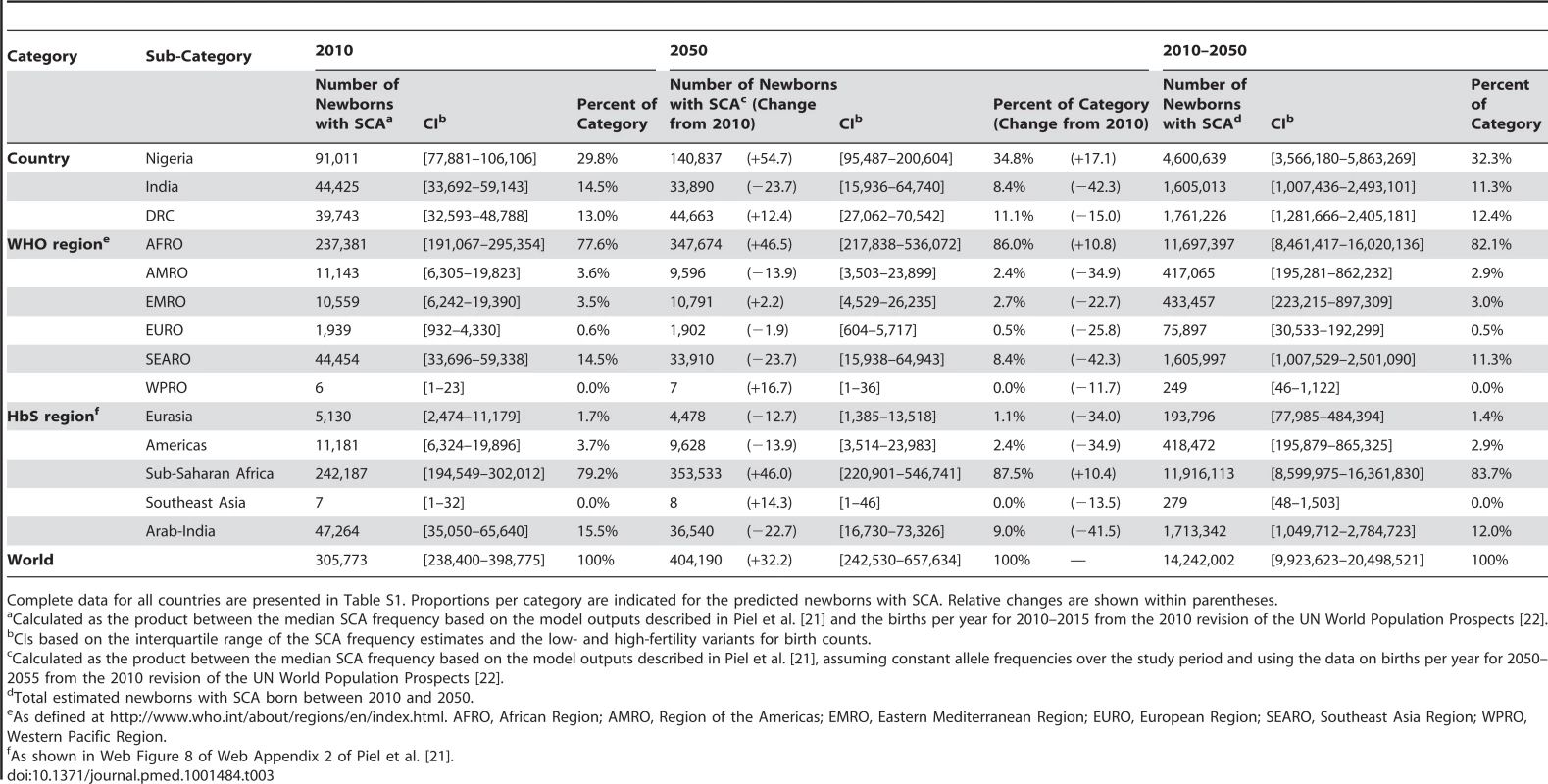
Regionally, in 2010, an estimated 79% (242,200 [CI: 194,500 (82%)–302,000 (76%)]) of newborns with SCA occurred in sub-Saharan Africa (Table 3; Figure 2A). This proportion is expected to increase to 88% (353,500 [CI: 220,900 (91%)–546,700 (83%)]) by 2050 (Table 3; Figure 2B). In contrast, based on the UN demographic projections, the proportion of newborns with SCA in the other HbS regions (Eurasia, the Americas, and Arab-India), apart from Southeast Asia, where SCA burden is very small, is expected to decrease (Table 3).
In 2010, we estimated that three countries (Nigeria, India, and the Democratic Republic of the Congo [DRC]) represented 57% (175,200 [CI: 144,200 (60%)–214,000 (54%)]) of the annual number of newborns with SCA globally (305,800 [CI: 238,400–398,800]). By 2050, these countries are projected to represent 55% (219,400 [CI: 138,500–335,900] amongst 404,200 [CI: 242,500–657,600]). But while the relative contribution of Nigeria is projected to increase from 30% (91,000 [CI: 77,900 (33%)–106,100 (27%)]) to 35% (140,800 [CI: 95,500 (39%)–200,600 (31%)]), the DRC's and India's relative contributions are expected to decrease from 13% (39,700 [CI: 32,600 (14%)–48,800 (12%)]) to 11% (44,700 [CI: 27,100 (11%)–70,500 (11%)]) and from 15% (44,400 [CI: 33,700 (15%)–59,100 (12%)]) to 8% (33,900 [CI: 15,900 (7%)–64,700 (10%)]), respectively. Projections for the three most affected countries, regions, and the world are plotted in Figure 5. Estimates for 2010, 2050, and 2010–2050 at national, regional, and global scales are presented in Table S2 and plotted for selected countries in Figure 3.
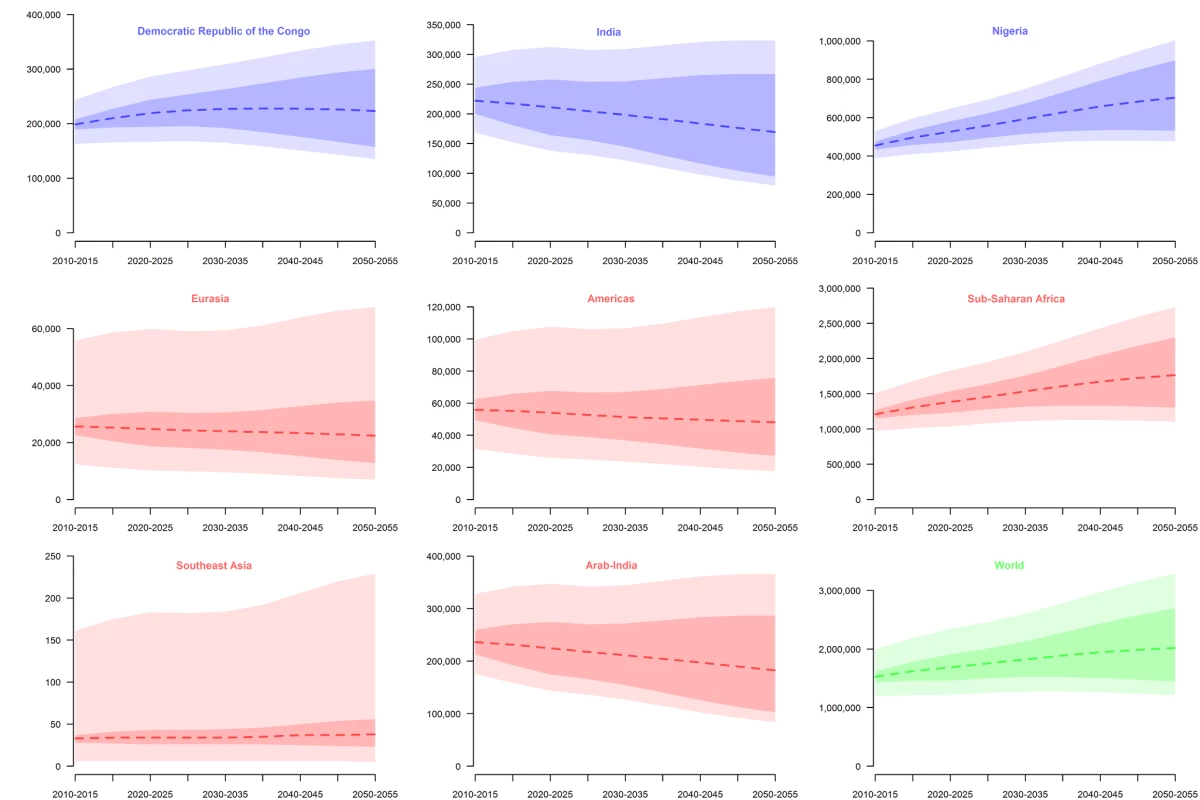
Estimated SCA Deaths and Lives Saved
By comparing the results of our scenarios with additional interventions (Scenarios 2, 3, and 4) with the scenario based on current practice (Scenario 1), we estimated the number of lives that could be saved at different scales (Tables 4 and S1). A global transition from Scenario 1 to Scenario 2 in 2015, would save 113,500 [CI: 85,100–152,900] newborns in 2015 and a total of 5,302,900 [CI: 3,174,800–6,699,100] newborns by 2050. A similar transition to Scenario 3 would almost double the number of newborns saved in 2015 and overall between 2015 and 2050. Transitioning to Scenario 4 in 2015 would save 241,100 [CI: 180,800–324,900] newborns with SCA in 2015 and a total of 9,806,000 [CI: 6,745,800–14,232,700] by 2050.
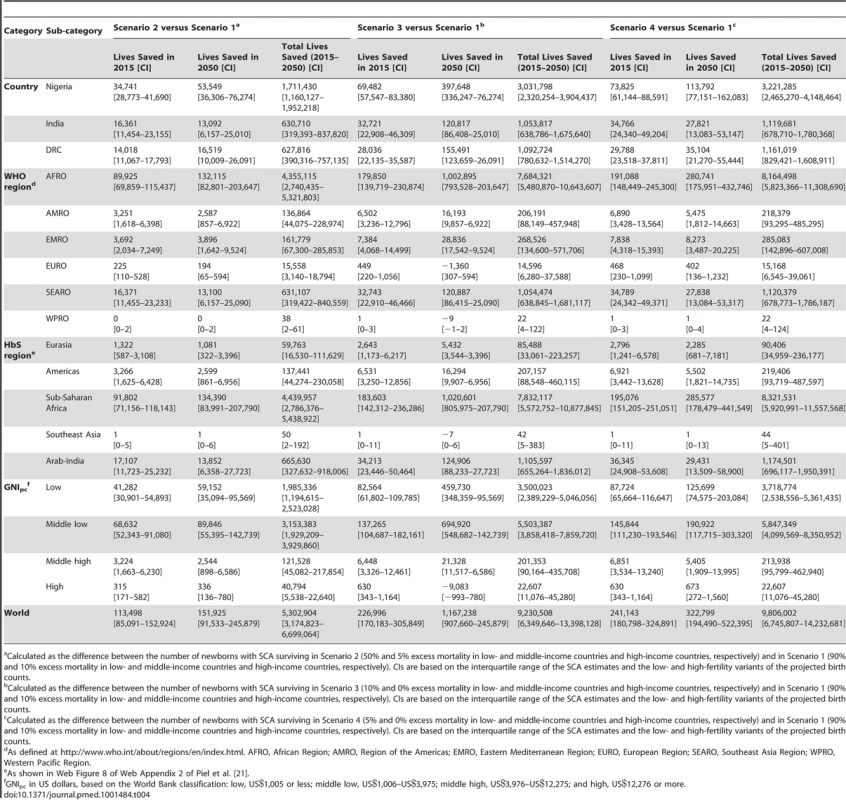
The vast majority of SCA-affected newborn lives that could be saved occur in sub-Saharan Africa. This is obvious when looking at the annual estimates for 2010 and 2050, but even more striking when looking at the overall calculations of lives lost over the 35-y projected period from 2015 to 2050 (Table 4). Nigeria's contribution to the global burden of SCA is particularly important. Based on GNIpc, more than 95% of the mortality burden among newborns with SCA will fall to low - and middle-low-income countries (Table 4).
Our radar charts illustrate the different types of challenges that are faced by different countries (Figures 4 and S1). For example, in the DRC, the expected increase in the number of newborns with SCA (from 39,800 [CI: 32,600–48,800] to 44,700 [CI: 27,100–70,500]) will probably be accompanied by significant improvements in survival (reduction of U5m from 180 to 75 per 1,000). This will result in growing pressure on health care services during a period in which the economic status of the country is not expected to experience significant improvements (an increase in the GDPpc from US$3,812 to only US$4,135) (Figure 4A; Table S3). Nigeria will likely see a very large increase in the number of newborns with SCA (from 91,000 [CI: 77,900–106,100] in 2010 to 140,800 [CI: 95,500–200,600] in 2050), while U5m is projected to decrease from 141 to 49 per 1,000. This will aggravate the national health burden of SCA to an extent that will be poorly compensated by the projected increase in its GDPpc from US$2,137 to US$9,015 (Figure 4B; Table S3). Conversely, the situation seems a little less alarming in India, where we project that the number of newborns with SCA will decrease from 44,400 (CI: 33,700–59,100) to 33,900 (CI: 15,900–64,700), while GDPpc will increase by 6-fold (from US$3,062 to US$19,553) (Figure 4C; Table S3), a situation that will potentially make the SCA burden more manageable in that country.
Discussion
Despite slowly growing awareness about haemoglobinopathies, and sickle cell disorders in particular, epidemiological data on the prevalence and burden of these disorders are still lacking [6],[21],[37]. In difficult economic times, evidence-based studies to support public health decisions and spending become increasingly important [38]. It has been suggested that the burden of haemoglobinopathies is going to increase over the coming decades [6],[39]. Such an increase is largely driven by two factors: population growth and public health transition. This study is, to our knowledge, the first attempt to quantify the magnitude of such increases based on existing epidemiological estimates and demographic projections. Our study highlights major inequalities in the current global distribution of newborns with SCA that are unlikely to be reduced in the coming decades. Basic interventions targeted to the most affected countries could save the lives of almost 10 million children born with SCA in the next 35 y.
The countries most affected face major challenges [37]. Currently, excess mortality in SCA patients in many low - and middle-income countries—most of whom remain undiagnosed—is extremely high, and SCA is often neglected in public health policies. It is anticipated that as overall U5m begins to fall because of improved nutrition and medical facilities, an increasing proportion of children under 5 y with SCA will survive long enough to reach medical attention. Public health improvements (including widespread use of prophylactic penicillin and vaccination) will help an increasing proportion of these children to survive through childhood and adulthood, and therefore to present for diagnosis and treatment (e.g., hydroxyurea, hospitalisation, transfusion) generating lifelong costs. The lack of interventions will inevitably lead to a large burden on the public health infrastructures and budgets of the countries most affected [40],[41]. This needs to be acknowledged by policy makers so that adequate planning can be used to save lives and keep treatment costs manageable. In the short term, the priority in countries with a high frequency of HbS is to identify affected births in order to provide appropriate treatment. Cheap diagnostic methods are available for HbS, and the cost-effectiveness of screening programmes has already been demonstrated [42],[43]. This study suggests that huge numbers of lives could be saved in Nigeria [44]–[46], the DRC [47]–[49], and India [50]–[52]. Some pilot screening programmes have recently started in these countries, but nationwide programmes are needed for a significant public health impact. In the long term, in the absence of a definitive treatment for SCA, the best intervention to reduce excess mortality caused by this disorder and to keep public health costs associated with the follow-up care of SCA patients through their lifetime manageable, especially in low-income countries, is to avoid the births of affected newborns [6],[37]. A good knowledge of individual status, including carriers, combined with a good education system about the inheritance mechanism of HbS and the risks associated might help reduce the number of newborns with SCA, but current evidence suggests that prenatal diagnosis and genetic counselling is more effective [40],[53]–[55]. Because of population diaspora, increasing admixture, and the absence of clinical symptoms in carriers, at-risk couples include a much larger subset of the population than originally estimated. Nevertheless, the idea that this disorder is confined to individuals of African origins is still common amongst the medical community, and this needs to change. Finally, it is essential to implement systems for monitoring temporal and spatial changes in the frequency of such disorders. In order to assess the efficiency of implemented policies, such systems need to collect reliable data from multiple health centres across a given country and to develop appropriate analytical methods.
Despite its novelty, this study has several limitations. First, it focuses only on newborns. Very few morbidity and mortality data are available for SCA patients, particularly in low-income countries, where deaths are usually attributed to other causes. Until universal screening at the population level is implemented, it is crucial to gather information on the mortality of SCA patients in order to define the public health and economic costs associated with HbS. It is likely that public health interventions such as those described here would result in indirect benefits for other age groups, but appropriate care for adults with SCA is something that also needs to be considered. Second, we have assumed that the implementation of specific interventions would lead to an immediate reduction of the excess mortality in newborns with SCA [27],[29],[56]. Although the benefits of these interventions have been clearly demonstrated in studies conducted in high-income countries, their implementation in low - and middle-income countries, in which general health infrastructures are poor, might be more challenging than assumed in this study. In addition, data on the costs of implementing interventions for children with SCA in low - and middle-income countries are currently lacking. Further studies on issues such as these will be needed before the optimal use of resources in different economic contexts can be defined. Third, the clinical phenotype of sickle cell disorders is very broad, being influenced by both genetic factors (e.g., α-thalassaemia or high levels of haemoglobin F) and environmental factors (e.g., infections) [57]. Moreover, there is some evidence to suggest that the Arab-Indian haplotype is milder than the African haplotypes [58]–[60]. If this is confirmed by large-scale population surveys, the economic burden in countries in which this haplotype is predominant might be lower than that in countries where the African haplotypes are prevalent. Current evidence was too sparse to account for this in the present study. Fourth, consanguineous marriages considerably increase the risk of having children with SCA in areas where the allele frequency of HbS is high. Such marriages are common in the Middle East and in various population groups worldwide, but only limited data are available globally [61],[62]. Finally, we assumed constant allele frequencies over the time period studied (40 y) [24],[25]. This assumption, which is based on the slow kinetics of inherited disorders, neglects the influence of population migrations. The magnitude and direction of past and current intra - or international population movements, often caused by political instability, civil disturbances, or environmental disasters, are difficult to assess. Allele frequencies within one country can be highly heterogeneous, making assumptions based only on nationality highly uncertain. Furthermore, it is almost impossible to predict future movements. Accessing immigration data [63] and using mobile phone network data [64],[65] for international migrations would be possible, but this is currently beyond the scope of this project.
Conclusion
Multiple warnings regarding the effect of epidemiological and demographic transitions in low-income countries and their consequences for SCA burden have been published [6],[66]. By quantifying this increase from 2010 to 2050 using evidence-based data and identifying potential changes in the distribution of areas the most affected, we hope (i) to highlight further the need for greater awareness of SCA, appropriate public health policies, and funding; (ii) to guide the implementation of appropriate policies; and (iii) to provide a framework that could be applied to other birth defects. In most countries, the burden of SCA has so far not been recognised. Its long-term toll is nevertheless significant. These results highlight once more the need for further epidemiological collaborative studies, particularly in Nigeria, the DRC, and India, to define more accurately the current and future health burden of SCA.
Supporting Information
Zdroje
1. KomatsuR, KorenrompEL, Low-BeerD, WattC, DyeC, et al. (2010) Lives saved by Global Fund-supported HIV/AIDS, tuberculosis and malaria programs: estimation approach and results between 2003 and end-2007. BMC Infect Dis 10 : 109.
2. KatzI, KomatsuR, Low-BeerD, AtunR (2011) Scaling up towards international targets for AIDS, tuberculosis, and malaria: contribution of global fund-supported programs in 2011–2015. PLoS ONE 6: e17166 doi:10.1371/journal.pone.0017166
3. Christianson AC, Howson CP, Modell B (2006) The March of Dimes global report on birth defects: the hidden toll of dying and disabled children. White Plains (New York): March of Dimes.
4. Howson CP, Christianson AC, Modell B (2008) Controlling birth defects: reducing the hidden toll of dying and disabled children in lower-income countries. Washington (District of Columbia): Disease Control Priorities Project.
5. WeatherallD (2011) The inherited disorders of haemoglobin: an increasingly neglected global health burden. Indian J Med Res 134 : 493–497.
6. WeatherallDJ (2010) The inherited diseases of hemoglobin are an emerging global health burden. Blood 115 : 4331–4336.
7. ReesDC, WilliamsTN, GladwinMT (2010) Sickle-cell disease. Lancet 376 : 2018–2031.
8. ModellB, DarlisonM (2008) Global epidemiology of haemoglobin disorders and derived service indicators. Bull World Health Organ 86 : 480–487.
9. PielFB, PatilAP, HowesRE, NyangiriOA, GethingPW, et al. (2010) Global distribution of the sickle cell gene and geographical confirmation of the malaria hypothesis. Nat Commun 1 : 104.
10. GrosseSD, OdameI, AtrashHK, AmendahDD, PielFB, et al. (2011) Sickle cell disease in Africa: a neglected cause of early childhood mortality. Am J Prev Med 41: S398–S405.
11. WilliamsTN, UyogaS, MachariaA, NdilaC, McAuleyCF, et al. (2009) Bacteraemia in Kenyan children with sickle-cell anaemia: a retrospective cohort and case-control study. Lancet 374 : 1364–1370.
12. ScottJA, BerkleyJA, MwangiI, OcholaL, UyogaS, et al. (2011) Relation between falciparum malaria and bacteraemia in Kenyan children: a population-based, case-control study and a longitudinal study. Lancet 378 : 1316–1323.
13. RajaratnamJK, MarcusJR, FlaxmanAD, WangH, Levin-RectorA, et al. (2010) Neonatal, postneonatal, childhood, and under-5 mortality for 187 countries, 1970–2010: a systematic analysis of progress towards Millennium Development Goal 4. Lancet 375 : 1988–2008.
14. LiuL, JohnsonHL, CousensS, PerinJ, ScottS, et al. (2012) Global, regional, and national causes of child mortality: an updated systematic analysis for 2010 with time trends since 2000. Lancet 379 : 2151–2161.
15. FotsoJC, EzehAC, MadiseNJ, CieraJ (2007) Progress towards the child mortality millennium development goal in urban sub-Saharan Africa: the dynamics of population growth, immunization, and access to clean water. BMC Public Health 7 : 218.
16. SayemAM, NuryAT, HossainMD (2011) Achieving the millennium development goal for under-five mortality in Bangladesh: current status and lessons for issues and challenges for further improvements. J Health Popul Nutr 29 : 92–102.
17. MasseyDS, ArangoJ, HugoG, KouaouciA, PellegrinoA, et al. (1993) Theories of international migration: a review and appraisal. Popul Dev Rev 19 : 431–466.
18. World Health Organization (2006) Fifty-ninth World Health Assembly: resolutions and decisions, annexes. WHA59/2006/REC/1. Geneva: World Health Organization.
19. MurrayCJL, EzzatiM, FlaxmanAD, LimS, LozanoR, et al. (2012) GBD 2010: a multi-investigator collaboration for global comparative descriptive epidemiology. Lancet 380 : 2055–2058.
20. MyersMF, RogersDJ, CoxJ, FlahaultA, HaySI (2000) Forecasting disease risk for increased epidemic preparedness in public health. Adv Parasitol 47 : 309–330.
21. PielFB, PatilAP, HowesRE, NyangiriOA, GethingPW, et al. (2013) Global epidemiology of sickle haemoglobin in neonates: a contemporary geostatistical model-based map and population estimates. Lancet 380 : 142–151.
22. United Nations Population Division (2010) World population prospects, the 2010 revision. New York: United Nations Population Division. Available: http://esa.un.org/unpd/wpp/index.htm. Accessed 12 June 2013.
23. LivingstoneFB (1964) Aspects of the population dynamics of the abnormal hemoglobin and glucose-6-phosphate dehydrogenase deficiency genes. Am J Hum Genet 16 : 435–450.
24. Bodmer WF, Cavalli-Sforza LL (1976) Genetics, evolution, and man. San Francisco: W. H. Freeman. 782 p.
25. HanchardNA, HambletonI, HardingRM, McKenzieCA (2005) The frequency of the sickle allele in Jamaica has not declined over the last 22 years. Br J Haematol 130 : 939–942.
26. YanniE, GrosseSD, YangQ, OlneyRS (2009) Trends in pediatric sickle cell disease-related mortality in the United States, 1983–2002. J Pediatr 154 : 541–545.
27. VichinskyE, HurstD, EarlesA, KlemanK, LubinB (1988) Newborn screening for sickle cell disease: effect on mortality. Pediatrics 81 : 749–755.
28. LeeA, ThomasP, CupidoreL, SerjeantB, SerjeantG (1995) Improved survival in homozygous sickle cell disease: lessons from a cohort study. BMJ 311 : 1600–1602.
29. KingL, FraserR, ForbesM, GrindleyM, AliS, et al. (2007) Newborn sickle cell disease screening: the Jamaican experience (1995–2006). J Med Screen 14 : 117–122.
30. FlemingAF, StoreyJ, MolineauxL, IrokoEA, AttaiED (1979) Abnormal haemoglobins in the Sudan savanna of Nigeria. I. Prevalence of haemoglobins and relationships between sickle cell trait, malaria and survival. Ann Trop Med Parasitol 73 : 161–172.
31. PlattOS, BrambillaDJ, RosseWF, MilnerPF, CastroO, et al. (1994) Mortality in sickle cell disease. Life expectancy and risk factors for early death. New Engl J Med 330 : 1639–1644.
32. SimporeJ, PignatelliS, BarlatiS, MusumeciS (2002) Modification in the frequency of Hb C and Hb S in Burkina Faso: an influence of migratory fluxes and improvement of patient health care. Hemoglobin 26 : 113–120.
33. QuinnCT, RogersZR, BuchananGR (2004) Survival of children with sickle cell disease. Blood 103 : 4023–4027.
34. QuinnCT, RogersZR, McCavitTL, BuchananGR (2010) Improved survival of children and adolescents with sickle cell disease. Blood 115 : 3447–3452.
35. TelferP, CoenP, ChakravortyS, WilkeyO, EvansJ, et al. (2007) Clinical outcomes in children with sickle cell disease living in England: a neonatal cohort in East London. Haematologica 92 : 905–912.
36. SaaryMJ (2008) Radar plots: a useful way for presenting multivariate health care data. J Clin Epidemiol 61 : 311–317.
37. WeatherallDJ (2011) The challenge of haemoglobinopathies in resource-poor countries. Br J Haematol 154 : 736–744.
38. BrownsonRC, FieldingJE, MaylahnCM (2009) Evidence-based public health: a fundamental concept for public health practice. Annu Rev Public Health 30 : 175–201.
39. Weatherall D, Akinyanju O, Fucharoen S, Olivieri N, Musgrove P (2006) Inherited disorders of hemoglobin. In: Jamison DT, Breman JG, Measham AR, Alleyne G, Claeson M, et al.., editors. Disease control priorities in developing countries, 2nd edition. New York: Oxford University Press. pp. 663–680.
40. Weatherall DJ, Clegg JB (2001) The thalassaemia syndromes. Oxford: Blackwell Science. 846 p.
41. de SilvaS, FisherCA, PremawardhenaA, LamabadusuriyaSP, PetoTEA, et al. (2000) Thalassaemia in Sri Lanka: implications for the future health burden of Asian populations. Lancet 355 : 786–791.
42. PanepintoJA, MagidD, RewersMJ, LanePA (2000) Universal versus targeted screening of infants for sickle cell disease: a cost-effectiveness analysis. J Pediatr 136 : 201–208.
43. GrosseSD, OlneyRS, BailyMA (2005) The cost effectiveness of universal versus selective newborn screening for sickle cell disease in the US and the UK: a critique. Appl Health Econ Health Policy 4 : 239–247.
44. OdunvbunME, OkoloAA, RahimyCM (2008) Newborn screening for sickle cell disease in a Nigerian hospital. Public Health 122 : 1111–1116.
45. Adeola AnimasahunB, NwodoU, NjokanmaOF (2012) Prenatal screening for sickle cell anemia: awareness among health professionals and medical students at the Lagos University Teaching Hospital and the concept of prevention by termination. J Pediatr Hematol Oncol 34 : 252–256.
46. Akinyanju O (2010) The national burden of sickle cell disorder and the way forward. Lagos: Sickle Cell Foundation Nigeria.
47. TshiloloL, KafandoE, SawadogoM, CottonF, VertongenF, et al. (2008) Neonatal screening and clinical care programmes for sickle cell disorders in sub-Saharan Africa: lessons from pilot studies. Public Health 122 : 933–941.
48. AgasaB, BosungaK, OparaA, TshilumbaK, DupontE, et al. (2010) Prevalence of sickle cell disease in a northeastern region of the Democratic Republic of Congo: what impact on transfusion policy? Transfus Med 20 : 62–65.
49. TshiloloL, AissiLM, LukusaD, KinsiamaC, WembonyamaS, et al. (2009) Neonatal screening for sickle cell anaemia in the Democratic Republic of the Congo: experience from a pioneer project on 31 204 newborns. J Clin Pathol 62 : 35–38.
50. PatraPK, ChauhanVS, KhodiarPK, DallaAR, SerjeantGR (2011) Screening for the sickle cell gene in Chhattisgarh state, India: an approach to a major public health problem. J Community Genet 2 : 147–151.
51. DasR (2012) Micro mapping the frequencies of beta thalassemia and sickle cell anemia in India: a way forward to plan control strategies. Indian J Hum Genet 18 : 148–149.
52. MohantyD, ColahRB, GorakshakarAC, PatelRZ, MasterDC, et al. (2013) Prevalence of beta-thalassemia and other haemoglobinopathies in six cities in India: a multicentre study. J Community Genet 4 : 33–42.
53. AlswaidiFM, MemishZA, O'BrienSJ, Al-HamdanNA, Al-EnzyFM, et al. (2012) At-risk marriages after compulsory premarital testing and counseling for beta-thalassemia and sickle cell disease in Saudi Arabia, 2005–2006. J Genet Couns 21 : 243–255.
54. CaoA, GalanelloR, RosatelliMC (1998) Prenatal diagnosis and screening of the haemoglobinopathies. Baillieres Clin Haematol 11 : 215–238.
55. LoukopoulosD (2011) Haemoglobinopathies in Greece: prevention programme over the past 35 years. Indian J Med Res 134 : 572–576.
56. GastonMH, VerterJI, WoodsG, PegelowC, KelleherJ, et al. (1986) Prophylaxis with oral penicillin in children with sickle cell anemia. A randomized trial. New Engl J Med 314 : 1593–1599.
57. Serjeant GR (2001) Geographic hetereogeneity of sickle cell disease. In: Steinberg MH, Forget BG, Higgs DR, Nagel RL, editors. Disorders of hemoglobin, 1st edition. Cambridge: Cambridge University Press.
58. JainD, ItaliaK, SarathiV, GhoshandK, ColahR (2012) Sickle cell disease from central India: a retrospective analysis. Indian Pediatr 49 : 911–913.
59. KulozikAE, WainscoatJS, SerjeantGR, KarBC, Al-AwamyB, et al. (1986) Geographical survey of beta S-globin gene haplotypes: evidence for an independent Asian origin of the sickle-cell mutation. Am J Hum Genet 39 : 239–244.
60. KulozikAE, KarBC, SatapathyRK, SerjeantBE, SerjeantGR, et al. (1987) Fetal hemoglobin levels and beta (s) globin haplotypes in an Indian populations with sickle cell disease. Blood 69 : 1742–1746.
61. BittlesA (2001) Consanguinity and its relevance to clinical genetics. Clin Genet 60 : 89–98.
62. BittlesAH (2002) Endogamy, consanguinity and community genetics. J Genet 81 : 91–98.
63. Organisation for Economic Co-operation and Development (2013) International migration database [database]. Paris: Organisation for Economic Co-operation and Development.
64. TatemAJ, QiuY, SmithDL, SabotO, AliAS, et al. (2009) The use of mobile phone data for the estimation of the travel patterns and imported Plasmodium falciparum rates among Zanzibar residents. Malar J 8 : 287.
65. LuX, BengtssonL, HolmeP (2012) Predictability of population displacement after the 2010 Haiti earthquake. Proc Natl Acad Sci U S A 109 : 11576–11581.
66. WeatherallDJ, CleggJB (2001) Inherited haemoglobin disorders: an increasing global health problem. Bull World Health Organ 79 : 704–712.
Štítky
Interní lékařstvíČlánek vyšel v časopise
PLOS Medicine
2013 Číslo 7
- Není statin jako statin aneb praktický přehled rozdílů jednotlivých molekul
- S MUDr. Kamilou Kotíkovou o novém pilíři včasné diagnostiky osteoporózy − denzitometrii v gynekologické praxi
- Osteoporóza v praxi: Kdy léčit v primární péči a kdy referovat do osteocentra?
- Biomarker NT-proBNP má v praxi široké využití. Usnadněte si jeho vyšetření POCT analyzátorem Afias 1
- Existují rozdíly v dlouhodobé účinnosti různých trojkombinací v léčbě hypertenze?
Nejčtenější v tomto čísle
- Changes in Association between Previous Therapeutic Abortion and Preterm Birth in Scotland, 1980 to 2008: A Historical Cohort Study
- Multiplex Identification of Gram-Positive Bacteria and Resistance Determinants Directly from Positive Blood Culture Broths: Evaluation of an Automated Microarray-Based Nucleic Acid Test
- Combatting Substandard and Falsified Medicines: A View from Rwanda
- Reflections on the Global Burden of Disease 2010 Estimates
